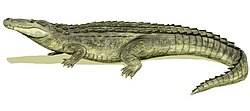| Balanerodus | |
|---|---|
| Scientific classification | |
| Kingdom: | Animalia |
| Phylum: | Chordata |
| Class: | Reptilia |
| Clade: | Archosauria |
| Order: | Crocodilia |
| Superfamily: | Alligatoroidea |
| Family: | Alligatoridae |
| Genus: | † Balanerodus Langston, 1965 |
| Type species | |
| †Balanerodus logimus Langston, 1965 | |
Balanerodus is an extinct monospecific genus of alligatorid crocodylian. [1] Fossils have been found from the Fitzcarrald Arch in the Peruvian Amazon and the La Victoria Formation of the Honda Group in Colombia and date back to the Friasian and Laventan regional South American land mammal ages of the Middle Miocene. [2] [3]





